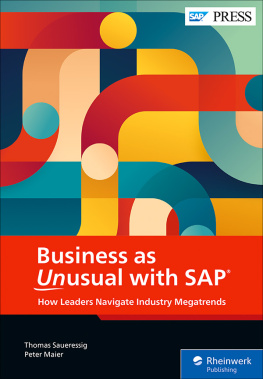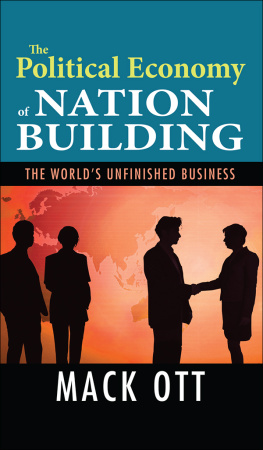Mirchandani - SAP Nation: a runaway software economy
Here you can read online Mirchandani - SAP Nation: a runaway software economy full text of the book (entire story) in english for free. Download pdf and epub, get meaning, cover and reviews about this ebook. year: 2014, publisher: Deal Architect Inc, genre: Politics. Description of the work, (preface) as well as reviews are available. Best literature library LitArk.com created for fans of good reading and offers a wide selection of genres:
Romance novel
Science fiction
Adventure
Detective
Science
History
Home and family
Prose
Art
Politics
Computer
Non-fiction
Religion
Business
Children
Humor
Choose a favorite category and find really read worthwhile books. Enjoy immersion in the world of imagination, feel the emotions of the characters or learn something new for yourself, make an fascinating discovery.

- Book:SAP Nation: a runaway software economy
- Author:
- Publisher:Deal Architect Inc
- Genre:
- Year:2014
- Rating:3 / 5
- Favourites:Add to favourites
- Your mark:
- 60
- 1
- 2
- 3
- 4
- 5
SAP Nation: a runaway software economy: summary, description and annotation
We offer to read an annotation, description, summary or preface (depends on what the author of the book "SAP Nation: a runaway software economy" wrote himself). If you haven't found the necessary information about the book — write in the comments, we will try to find it.
Mirchandani: author's other books
Who wrote SAP Nation: a runaway software economy? Find out the surname, the name of the author of the book and a list of all author's works by series.
SAP Nation: a runaway software economy — read online for free the complete book (whole text) full work
Below is the text of the book, divided by pages. System saving the place of the last page read, allows you to conveniently read the book "SAP Nation: a runaway software economy" online for free, without having to search again every time where you left off. Put a bookmark, and you can go to the page where you finished reading at any time.
Font size:
Interval:
Bookmark:
NATION
a runaway
software economy
VINNIE
MIRCHANDANI
author, The New Polymath
Copyrighted Material
SAP Nation
Copyright 2014 by Deal Architect Inc. All Rights Reserved.
No part of this publication may be reproduced, stored in a retrieval system or transmitted, in any form or by any means electronic, mechanical, photocopying, recording or otherwise without prior written permission from the publisher, except for the inclusion of brief quotations in a review.
For information about this title or to order bulk copies and/or electronic media, and for SAP and other IT advisory services, contact:
Deal Architect, Inc
P.O. Box 262262, Tampa, FL 33685, USA
www.dealarchitect.typepad.com
Updates to the book at www.sapnation.com
ISBNs: 978-0-9909296-1-1 (soft cover)
978-0-9909296-0-4 (eBook)
978-0-9909296-2-8 (Hardback bulk copies only)
Printed in the United States of America
Cover and Interior design: 1106 Design
This book is dedicated to customers the underappreciated stakeholders in the IT industry.

I first thought about writing this book five years ago.
In February 2009, I was invited to an SAP event in New York City where the company announced Business Suite 7, the latest version of its high-end ERP software that runs operations at many a Fortune 500 company and other enterprises. After the formal presentations, then-co-CEO Leo Apotheker sat down with a few of us analysts for Q&A.
Most of us wanted to talk about the recently announced maintenance price increase, which was proving unpopular with SAP customers, coming as it did in the deep recession. We also wanted to discuss why ECC6.0, their previous version of the ERP software, was seeing slow uptake among customers. But, Apotheker was irritated that none of us wanted to talk about Business Suite 7.
As I wrote the next day:
Alternatively defensive and feisty, there was piss and vinegar that I hope Leo turns into action.
It started off with Leo accusing me of spreading rumors about SAP overruns and little productivity improvement in systems integrator (SI) work plans over the years. Forget that the legions of staff in the SAP ecosystem and the hundreds of billions of dollars and euros and yens in SAP customer TCO models confirm my rumors. Have done so for 15+ years now.
To my point that SAPs efforts have done little to improve productivity in data migration, user acceptance testing and other implementation phases around core SAP functions, he proceeded to discuss tools SAP has delivered in many of the areas.
What about the fact that these tools have not driven significant productivity in SI proposals? Leo bravely said, If we believe [a project] takes 500 days and another partner says its 5,000 days, Ill do it for 500 and a fixed fee.
To our point that in the field it often appears partner interests trump those of the customer, Leo was at his passionate best: Ive been in the field all my life. That monster out there [the field] is my creature. Loyalty is to the customer. The obligation is to the customer, and I dont give a s**t if its Accenture or IBM. I care about the customer.
Unlike some other analysts who were in that room, I am also a consultant to CIOs, helping them evaluate SAP and partner proposals. I had to smile through Apothekers brave talk.
Then it turned interesting. Apotheker emailed me to say that I should not have published my note the conversation should have stayed private. That had not been communicated at the start of the meeting. In fact, some of the analysts in the room were live-tweeting the event. My column was already old news by the time it was published.
Nonetheless, I apologized in a follow-up post:
We got the chance to ask him tough questions, see him come out swinging, show spunk in the blogger session. We want him to continue to be that way. In return we owe it to him to not have to defend every word he says in that frame of passion. And we can do so while providing our readers the spirit of what is being discussed.
We goofed. Sorry, Leo. I hope we can continue that level of open conversation. On our part, we will use better judgment in how we report it.
Then it turned even more interesting. An SAP marketing executive called to ask if I would talk with Accenture and IBM and explain to them what had happened in the meeting. I grudgingly agreed. The calls never happened, but the damage was done. I was giving Apotheker credit for finally standing up to his partners as I had repeatedly asked over the years, and again SAP appeared to have backed down.
Despite those concerns, I did not write the SAP book at that time. Instead, I have written three books in the last five years, on technology-enabled innovation and the digital transformation journeys of companies. Also, I was convinced in 2009 that SAP had peaked and customer investments post-recession on their SAP projects would be much more modest.
About that, I was dead wrong.
Earlier this year, I had a chance to build a model of SAP Nation as Chapter 3 details. I was shocked that post-recession customers appear to have spent over a trillion dollars around SAP. This, when SAPs own sales and deliverables have leveled off. When you compare how nicely IT costs via software-as-a-service (SaaS) applications, cloud infrastructures and mobile broadband have dropped in the last few years, you have to ask why those in the SAP economy have not followed that trend. Likewise, when you see all the front-office technology opportunities in product and customer-facing areas you wonder how many are being crowded out by the SAP back office. Those vexing questions are what has convinced me to finally write this book.
The book is organized into five sections and four groups of customer strategies.
Section I sets the stage and shows that in spite of the customer and SAP pivots, the SAP economy keeps marching to its own drumbeat. Chapter 1 shows where innovative customers are moving their IT investment. Chapter 2 shows a significant shift in SAP investment away from leadership in business applications to a focus on platforms and acquisitions. Chapter 3 details our model of the SAP economy.
Section II documents the growth of the SAP economy over the last three decades. Chapter 4 covers the 1990s, Chapter 5 the 2000s, and Chapter 6 the current decade.
Section III investigates whether the huge spend in the SAP economy has yielded commensurate payback. In Chapter 7 we see that, in spite of the large investment and decades of experience, the casualties in SAP project failures and write-offs continue unabated. Chapter 8 covers the transformative waves of industrialization, consumerization, externalization and boardrooming of IT that have eluded many SAP customers.
Section IV looks at the root causes of how the SAP economy got to be so massive. Chapter 9 looks at SAPs own mistakes. Chapter 10 focuses on the role of partners in the SAP economy. Chapter 11 examines whether market watchers could have done more to highlight the bloat in the SAP economy. Chapter 12 evaluates why SAP customers have not done more to better manage the economics.
Section V looks at recent SAP and customer trends. Chapter 13 describes customers shifting IT priorities. Chapter 14 shows a glimmer of hope as SAP moves to newer business models and start-up ecosystems. Chapter 15 presents likely future scenarios for the SAP economy.
My model of the economy led me to call executives at SAP customers some that I have consulted with and several others. I wanted to hear what they were doing to optimize their SAP spend. Based on their feedback, I have classified their strategies in Case Study Groups A-D in four customer profiles:
Font size:
Interval:
Bookmark:
Similar books «SAP Nation: a runaway software economy»
Look at similar books to SAP Nation: a runaway software economy. We have selected literature similar in name and meaning in the hope of providing readers with more options to find new, interesting, not yet read works.
Discussion, reviews of the book SAP Nation: a runaway software economy and just readers' own opinions. Leave your comments, write what you think about the work, its meaning or the main characters. Specify what exactly you liked and what you didn't like, and why you think so.









